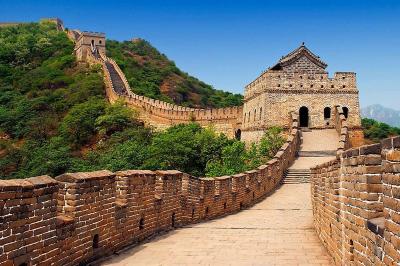How Big is the Great Wall of China?
The history of the construction of the Great Wall can be traced back to the Western Zhou Dynasty, when the Zhou Dynasty built a continuous line of castles called “Liancheng” for defence against the attacks of the northern nomadic tribe of Yanyuan. After the Qin Dynasty united China by destroying the six kingdoms, Emperor Qin Shi Huang connected and repaired the Great Wall of the Warring States, which became known as the Great Wall of China. Today, let's talk about how big the Great Wall is and explore the measurement of the Great Wall.
5 Interesting Figures on How Big the Great Wall is
1. The Great Wall of China stretches 13170.6 miles (21196.18 kilometers), with most of its parts located in North China.
2. The existing Great Wall was mainly built during the Ming Dynasty, with a total length of 8,851.8 kilometres, including 6,259.6 kilometres of artificial walls and 2,592.2 kilometres of natural barriers. It is mainly located in Hebei, Shanxi and Shaanxi.
3. The total length of the Qin-Han and prehistoric (Western Zhou) Great Wall exceeds 10,000 kilometres. Examples include the 2,498.54-kilometre Great Wall in Hebei Province and the 1,838-kilometre Great Wall in Shaanxi Province.
4. The foundations of the Wall are all 6.5 metres wide.
5. Heilongjiang, Jilin, Liaoning, Inner Mongolia, Beijing, Tianjin, Hebei, Shandong, Henan, Shanxi, Shaanxi, Gansu, Ningxia, Qinghai, and Xinjiang are among the 15 regions in northern China that the Great Wall covers.
How Long is the Great Wall of China?

The results of the Great Wall resource survey released by the State Administration of Cultural Heritage of China in 2012 confirmed that the total length of the Great Wall of China is 21,196.18 kilometres. It contains 43,721 remains of the Great Wall from various dynasties, such as walls, trenches, passes and forts, and is distributed in 15 provinces, autonomous regions and municipalities in China. This is the first scientific and systematic measurement of the total length of the Great Wall through the ages in China.
The Great Wall of China is not a continuous structure, but rather a series of walls, fortifications, and watchtowers. The wall was built using a variety of materials, including brick, stone, and earth. The construction of the wall was a massive undertaking, and it required a vast amount of resources and manpower. The wall was built in sections, with each section being constructed independently and then joined to the adjacent sections.
How Wide is the Great Wall of China?
The wall is the main part of the Great Wall of China, with an average height of 7.8 metres and some sections as high as 14 metres. Where the hillock is steep, it is constructed lower, and where it is flat, it is constructed higher; where it is critical, it is higher, and where it is general, it is lower. >> Learn more about how tall is the Great Wall of China
The total thickness of the walls, which are the main part of the defence against the enemy, is wide. The width of the foundations is 6.5 metres in all cases, and the width of the floor of the wall averages 5.8 metres. The body of the wall consists of an outer gable wall and an inner gable wall filled with clay rubble.
The outer gable wall is the side of the outer skin wall that faces out of town. When constructed, there is a clear point of closure, which is generally 125 per cent of the height of the wall. Inner gable wall refers to the outer skin wall of the city side, the construction of the general lack of obvious points, constructed as a vertical wall.
The thickness of the outer gable wall is generally based on the thickness of the wall at the “crenel”. Thickness is generally a brick and a half wide, according to the proportion of points. It gets thicker as it goes down.
The Great Wall bricks have different sizes and are mainly divided into the following categories:
1. The most common size is 39 cm long, 18 cm wide and 9 cm thick.
2.The relatively common size is 24 cm long, 11.5 cm wide, 5.3 cm thick. Additionally, the masonry has a mortar thickness of 8 to 10 mm, which means that the total square of the 13-meter brick masonry is precisely 4 bricks long plus mortar for 1 m, 8 bricks broad plus mortar for 1 m, and 16 bricks thick plus mortar for 1 m.
These simple small bricks were used to construct the massive Great Wall of China we see today.
>> Recommended Great Wall of China Tours:
Does the Great Wall surround all of china?
The wall stretches for 13170.6 miles (21196.18 kilometers) through northern China, but it does not surround the entire country. The Great Wall was built to protect China's northern borders from invading armies, and it was constructed in sections over 2000 years for several dynasties. The wall runs from Shanhaiguan on the east coast of China to Lop Nur in the west, passing through several provinces and municipalities, including Liaoning, Hebei, Tianjin, Beijing, Shanxi, Inner Mongolia, Shaanxi, Ningxia, Gansu, and Qinghai.
The Eastern End of the Great Wall of China
The eastern end of the Great Wall, like the head of a dragon, rises from East Tiger Mountain in Dandong, Liaoning Province. Located on the banks of the Yalu River and across the river from North Korea, the East Tiger Great Wall was built in the fifth year of the Ming Dynasty under the supervision of Han Bin, Deputy General of Liaodong, and is the easternmost starting point of the Ming Dynasty Great Wall. Along the coastline to the west, Huludao's Jiumenmen Great Wall is the only Great Wall on water in the Great Wall of China, with a total length of 1980 metres, spanning nine rivers. >> Keep reading Where does the Great Wall of China Start?
The Great Wall in Northern China

The Badaling Great Wall in Beijing is an important pass, and it is also the earliest Great Wall scenic spot to open to tourists and receive the most tourists. The Mutianyu Great Wall, with more than 90 per cent of its area covered by vegetation, is connected to the Gubeikou Great Wall in the east and Juyongguan Pass in the west. Simatai Great Wall, built in the early years of Hongwu of Ming Dynasty, shows its mysterious glamour under the light at night.
The Huangyaguan Great Wall in Tianjin, built in the seventh year of Tianbao in the Northern Qi Dynasty and redesigned by Qi Jiguang in the Ming Dynasty, is famous for its majestic and dangerous passes.
>> Recommended Beijing tours with the Great Wall:
The Great Wall in Inner Mongolia
The Great Wall of China stretches to Inner Mongolia, where the Great Wall of the Jin Dynasty and the Great Wall of the Ming Dynasty bear witness to the exchanges and fusions between the Central Plains empire and the steppe culture. The Great Wall of Jin was a vast project built by the Jin Dynasty for the defence of the nomads in the north. It stretches from Molidawa Daur Autonomous Region in the east to Shangmiao Gou in Wuchuan County in the west, with a total length of about 1,650 kilometres.
The Great Wall in West China
The total length of the Great Wall of Shanxi is more than 3,500 kilometres, with more than 1,500 kilometres of surviving walls and ruins in more than 40 counties in 9 cities. The Great Wall was built during the Warring States, Eastern Wei, Northern Qi, Northern Zhou, Sui, Song, Ming and Qing dynasties. >> Read more about Which dynasties are best known for constructing the Great Wall?
Shaanxi is one of the birthplaces of Chinese civilisation. Zhenbeitai in Yulin, Shaanxi is the most magnificent and imposing building in the ruins of the Great Wall of China. It is a majestic military fortress and observation post on the Great Wall of China, and and known as “one of the three wonders” of the Great Wall of China (Shanhaiguan in the east, Zhenbeitai in the middle, and Jiayuguan Pass in the west).
The Great Wall stretches to Ningxia, a land that has been a key border defence area in northwestern China since ancient times. From the Warring States period to the Ming Dynasty, many dynasties built the Great Wall here. The earliest surviving Great Wall in Ningxia is the Warring States Qin Great Wall built by King Zhaoxiang of Qin during the Warring States period. It starts from Lintao County in Gansu Province in the west, passes through Ningxia, Gansu and Shaanxi, and reaches Tokoto County in Inner Mongolia in the northeast, with a total length of more than 1,100 kilometres, and about 170 kilometres in Ningxia.
Gansu, as the main gateway of the ancient Silk Road, has many remains of the Great Wall. The starting point of the western end of the Great Wall of China in the Ming Dynasty, Jiayuguan Pass was built in the fifth year of Hongwu of the Ming Dynasty (1372 A.D.), 647 years ago.
Xinjiang has also preserved precious relics of the Great Wall. On the outskirts of Kuqa County, Aksu Region, the Kizil Gaha Beacon Flint stands quietly like an ancient guardian. It was built in the Western Han Dynasty, and is the best-preserved beacon site on the middle route of the ancient Silk Road.
The South Great Wall
The Southern Great Wall of China, also known as Miao Frontier Border Wall and Xiangxi Border Wall, is a set of military defence system built in western Hunan during the Ming and Qing dynasties. It is mainly located in the counties and cities of Fenghuang, Jishou, Luxi, Huayuan, Guzhang and Baojing in the western part of the Xiangxi Autonomous Prefecture. The South Great Wall has 88 sections of wall remaining, counting 12,944 metres in length.